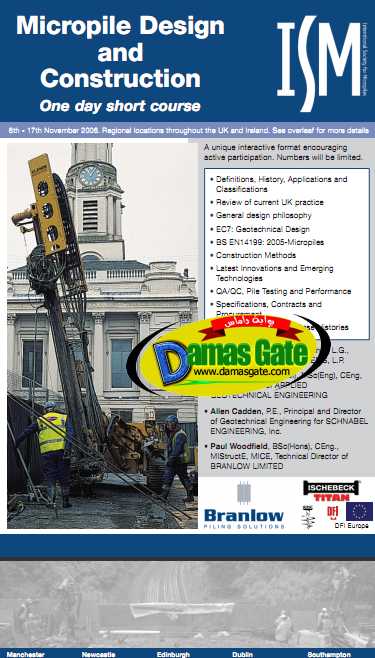Micropile Design and Construction

“This not for profit event organised by the International Society for Micropiles is
designed to promote greater understanding
of this specialist subject”
This consortium of international representatives involved in the research andevelopment, design, and construction of micropiles has been in existence since 1994. The core group was formed in 1994 as an international peer review team for the FHWA’s State of the Practice Study on Micropiles (19931997), which focused on “classic” micropiles, namely drilled and grouteelements of high capacity. The synergy of this group of individuals, allied withmajor demands for technology transfer to “newer” markets mainly from Japanand Scandinavia, led to the organization of the first workshop in Seattle, Win September 1997. Seven workshops were held since this initial meetingUbe, Japan (1999); Turku, Finland (2000); Lille, France (2001); Venice, Ital(2002); Seattle, WA (2003); Tokyo, Japan (2004); and SchrobenhausenGermany (2006). The workshops included a series of technical presentations and workshops complemented by local site visits and cultural events. Currenand past ISM activities may be reviewed on our website at
Micropiles are arguably the fastest growing specialty geotechnical constructiotechnology, with the market likely doubling in the last 5 years. The ISM habeen critical in the development of the technology internationally. Countriesponsoring delegates and providing major contributions to the IWM
throughout the years include the United States, France, Japan, Germany, Finland (and other Scandinavian countries), Italy, Belgium, Canada, the U.K., and Greece. The ISM has had over 80 active members, and each workshop has been attended by approximately 50 to 60 delegates. The goals of the ISMinclude:
Organize regular ISM meetings.
Establish a micropile database, especially of case histories and testing data, for use by designers, contractors, and educators worldwide.
Act as an international “authority” providing oversight input to local/national codes.
Act as a facilitator/disseminator of micropile information generated worldwide
Issue annual practice updates.
Help expand use of micropiles internationally by making knowledge available.
Act as a facilitator/coordinator/promoter for international research and demonstration programs (especially relating to seismic performance).
Identify fundraising vehicles to support membership needs and research efforts.
Develop educational tools.
Download
http://s18.alxa.net/s18/srvs2/02/001...nstruction.rar